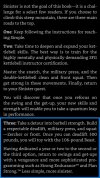You can progress in multiple areas at once (at least, that is my experience for myself and my coaching clients).
For example, when I was using S&S along with other training (and it included a lot of variety/exercises), I saw improvements in pretty much everything.
However, you don't have to progress in everything at the same time. Let them naturally go up in whatever time/fashion they do so.
When I first implemented S&S, I started with a 24kg kettlebell for two-arm swings and get-ups. After nearly four months, I was using 40kg for two-arm swings and 28kg for one-arm swings (and could do all 100 one-arm swings in 5 minutes with 24kg) and my Get-ups were up to 36kg. This was at a SHREDDED body-weight of 128lbs (I'm only 5'4" with very, very small joints/limbs and short muscle bellies/long tendons).
At the same time, I increased strength and/or reps in
dozens of other exercises from bodyweight to kettlebell to dumbbell, etc. This included pull-ups, dumbbell floor presses, overhead presses (singe and double kettlebell), Goblet Squats/DKFS, and others. And even though I wasn't performing them, my barbell 1RM Deadlift went up.
My training has essentially been 20-30 minute full-body workouts 3x/week since 2008/2009 and whatever else I may or may not do on the "off" days (i.e. S&S, Q&D, Murph Training, TSC training, etc.).
Right now, I'm performing three full-body workouts (45 minutes/session with warm-up) and two Q&D sessions (on the "off" days).
I have also used a concurrent training program for myself and my coaching clients for the last 13 years. Some may argue that concurrent training isn't good because of the interference effect, but I have not experienced that as an issue. I think that's only an issue for high-level athletes and those performing a good amount of cardio.
And by concurrent training, I don't mean resistance training and cardio (I rarely perform "cardio"). I mean that during a week of full-body workouts, they may look like this:
Mon: Strength
Wed: Power/HIRT
Fri: Hypertrophy
Or some variation of that including:
Mon: Metabolic Conditioning
Wed: Strength
Fri: Hypertrophy
And 90% of the time, I'm using circuits (EMOM, timed, etc.). Many on this forum will say you can't get stronger, build muscle, blah, blah, blah with circuits, and I'll be the first to tell you that's BS! For a good reference, see Chad Waterbury's new book: Elite Physique.
It has taken science/research more than a decade to finally prove that what some of us have been doing all this time is highly effective for about 90-95% of the population.


 ), but I got a lot stronger too.
), but I got a lot stronger too.
